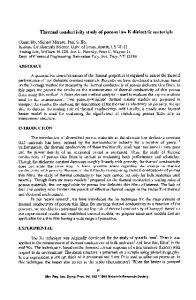Studies on dielectric constant and AC conductivity of nano porous silicon layer for efficient glucose sensing
- PDF / 1,667,907 Bytes
- 7 Pages / 595.276 x 790.866 pts Page_size
- 42 Downloads / 258 Views
Studies on dielectric constant and AC conductivity of nano porous silicon layer for efficient glucose sensing Tanusree Sarkar1, Nandini Mukherjee1, and Jayoti Das2,* 1 2
Department of Computer Science and Engineering, Jadavpur University, Kolkata 700032, India Department of Physics, Jadavpur University, Kolkata 700032, India
Received: 5 May 2020
ABSTRACT
Accepted: 4 September 2020
Dielectric constant and ac conductivity of surface functionalized nano porous silicon sensor platform have been studied for detection of hypo and hyper glycemia. Porous silicon layer is grown by electrochemical etching process. Structural morphology of the nano porous silicon layers before and after functionalization and with different glucose concentrations have been studied through X-ray diffraction pattern and FESEM images. Frequency dependence of dielectric constant and AC conductivity of surface functionalized nano porous silicon layers and the role of different polarizations are studied thoroughly. Also, the effect of adsorbed glucose concentration on dielectric properties and AC conductivity are analyzed.
Ó
Springer Science+Business
Media, LLC, part of Springer Nature 2020
1 Introduction Biosensors have become an essential research topic now a days in the field of disease diagnostic. Throughout the last decade, research in disease diagnostic has been flourished using different types of biosensors like DNA [1], protein [2], pathogen [3], urea [4], glucose [5, 6]. Diabetes is a chronic and harmful disease in our society. For quality life of the patients, early diagnosis and continuous monitoring are essential. Hence graphene [7, 8], zinc oxide nano rods [9], gold nano particles deposited indium tin oxide [10], Ag–Pt hollow nanoparticles and reduced graphene oxide [11], Ag@CuO core–shell nanostructure [12], silicon
Address correspondence to E-mail: [email protected]
https://doi.org/10.1007/s10854-020-04436-x
[13], carbon nano tube [14], different polymers [15, 16], porous silicon [17] based glucose sensors have been reported. Among these, porous silicon (PS) is becoming the most promising low cost material due to its large surface to volume ratio [18], controllable refractive index [19], room temperature photo and electroluminescence [20, 21], biocompatibility [21] and good adsorption property. Nanostructured PS shows distinctly different properties from bulk silicon. Nano PS layer has pronounced effect on surface strength and hardness for its granular like structure. The pore size and pore distribution can be controlled by changing hydrofluoric acid concentration in electrochemical solution, etching time, formation current density, doping concentration of the
J Mater Sci: Mater Electron
starting silicon wafer, etc [22]. Thus, it can be used as transducing material for different sensing applications like conductive [23], optical [24], chemical [25], gas [26, 27] and biosensor [24]. In earlier days, different techniques used for glucose detection were mainly optical based like Raman spectroscopy [28], fluorescence spe
Data Loading...




